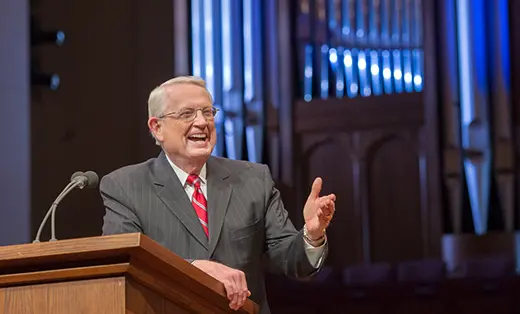Hope for Survival
By Pastor Chuck Swindoll

Originally, American settlers built their homes in the center of their acreage. Later on, many of them moved to the inside corners to be nearer their neighbors.
Understand, I wasn’t living back then, but from what I read, that’s actually what happened. It occurred when “Go west, young man!” was the challenge of America . . . when squatter’s rights seemed the most advantageous way to pry families loose and dare them to brave the elements via the covered wagon.
So out they came, exchanging the crowded, soot-choked industrial cities back East for the open plains, clear skies, and fertile, albeit rugged, farmland of the West.
Predictably, those early settlers built their cabins or sod huts smack dab in the middle of their homestead, acres (often miles) from the nearest family. Strong, sturdy fences marked property lines as pride of ownership became the badge of courage. Words like independence and private property were common table talk as the young were taught how to fight for survival.
But as time passed all that began to change. When photographers returned from those lonely houses, they showed pictures of wild-eyed women, stooped, gaunt, prematurely old men, and haunted-looking children. Life was hard making it on their own, especially through the bitter winters, fighting off disease and starvation.
The Lessons They Learned
More and more settlers learned that they had a better chance of making it if they would build their houses near each other, in the corner of their property rather than in the center. Four families could survive much easier if they loosened their grip on independence, built a gate in their fence, and relinquished their overstated emphasis on privacy. Enduring winter’s blast or a lengthy illness wasn’t nearly so frightful if you had three other families within walking distance. It proved to be much more fun coming together instead of living lonely, separate, touch-me-not lives of isolation.
From all this emerged a proverb:
“Shared joy is a double joy, shared sorrow is half a sorrow.”
Seasons for the year became more colorful, more hopeful. Farming, harvesting, canning, and slaughtering became group projects. Weddings and worship, gains and losses, births and deaths became shared experiences as mere existence was exchanged for real living . . . entering into each others’ joys as well as sorrows, neighbors becoming friends (then relatives!) . . . sharing in the many-faceted jewel called “living.”
Those old settlers learned what we seem to have forgotten today: pulling closer together is better than existing so far apart. Sharing is still to be preferred to staying aloof. The risks and periodic hassles notwithstanding, four in a corner are better than one in the middle. I’m confident that’s the whole point of Ecclesiastes 4:9-10, 12:
Two are better than one because they have a good return for their labor. For if either of them falls, the one will lift up his companion. But woe to the one who falls when there is not another to lift him up. . . . And if one can overpower him who is alone, two can resist him. A cord of three strands is not quickly torn apart.
Our Lessons to Learn
Chase the phrase “one another” through the last half of your New Testament and you’ll see what I mean. We really do need each other. More profoundly, more desperately than we even begin to realize. As a matter of fact, we were given to one another by the Lord of the body because each one of us has a unique something to contribute—a piece of the divine puzzle no one else on earth can supply (see Ephesians 4).
Where is your sod hut? Out in the middle of some lonely, windswept acres? How long has it been since you’ve had some significant, open-hearted, fences-down interaction with folks in a local body? Too long? Maybe it’s time you moved your hut to the corner of your field. Maybe it’s time you installed a gate for that high, forbidding fence. It could make a big difference in your life.
For some of you, it may even mean survival.
About the author
 Pastor Chuck Swindoll
Pastor Chuck Swindoll
Pastor Charles R. Swindoll has devoted his life to the accurate, practical teaching and application of God’s Word. He is the founding pastor of Stonebriar Community Church in Frisco, Texas, but Chuck’s listening audience extends far beyond a local church body. As a leading program in Christian broadcasting since 1979, Insight for Living airs around the world. Chuck’s leadership as president and now chancellor emeritus at Dallas Theological Seminary has helped prepare and equip a new generation of men and women for ministry.
